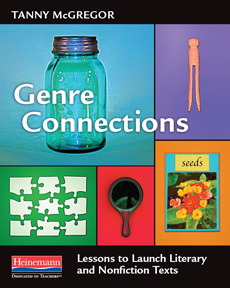My introduction technique for poetry came from Genre Connections: Lessons to Launch Literary and Nonfiction Texts by Tanny McGregor, published by Heinemann:

I loved the "jar" idea for introducing poetry. Here's how it went down:
I started by asking how poetry is like a jar as I held up a jar for the class to see. I then gave a very bland, factual description of my dad. Next, I talked about my dad in emotional terms, describing the way he shows his love and the kind of personality he has. As I gave these descriptions, I wrote them on slips of paper and dropped them into the jar. I then asked my students how poetry is like a jar. They started to make observations about the way I described with emotion and more description, then put those words in the jar. I told them they were on the right track and to keep thinking, then I asked them to discuss with their groups. It took a little work, but we eventually got around to the class deciding that poetry is like a jar because it is a vessel for holding emotions and feelings.
We created these charts after a collaborative activity where I distributed a number of poems in various formats. I gave the kids about 10-15 minutes to work in groups as they explored the poems and made observations about the format, content, meaning, and anything else they noticed. I drew the basic outlines on chart paper with the "Poetry Can" text ahead of time. I put them up on the wall and wrote their responses as we discussed what everyone had noticed during their discovery activity.
When selecting the poems for the discovery activity, I purposely chose some poems that didn't look like traditional poetry, and some that had distinctive traits that I hoped my students would key in on. For the most part, it worked! There were a few observations that I sort of steered, but overall, I was really impressed with what my students contributed.
One very interesting thing that I noticed about these is the difference in some of the more insightful observations made by my students. I have two 7th grade classes, and in one of the classes, over 2/3 of the students are struggling readers or students who perform below grade level in reading and writing. In addition, a number of them are ELLs. The other class is much more balanced with a proportional mix of academic abilities. Guess which class revealed deeper insights? I'll give you a hint - it was the class whose chart is shown in the second photo. Yep, my class with mostly lower-performing students!
I think the most exciting moment for me through this entire lesson occurred after we had completed this activity and debriefed. I turned to the class and asked, "So, if poetry doesn't really follow any rules, how can we tell when something is a poem?" Students in my higher level class immediately started blurting out guesses. None of them were wrong, per se, but nobody really hit the sweet spot with their answer, either. When I asked the same question of my "lower" class, I got a bunch of blank stares and a few thoughtful looks. Mindful of the ever-important wait time, I waited. And waited. And waited.
After what seemed like an eternity, one of my more gregarious boys widened his eyes, shot his hand up, and very nearly hopped out of his seat. I called on him, and he looked me straight in the eye, clutched his chest, and said, "You know it's poetry because it hits you right in the heart, Mrs. Bonner!"
Oh. My. GOODNESS!! I'm fairly certain tears welled up in my eyes. He got it. And his classmates chimed in their affirmation.
So very, very cool!


No comments:
Post a Comment